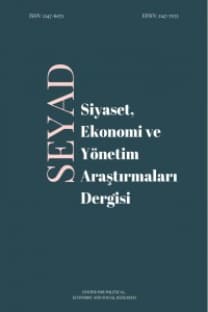Swot Analysis for Determining the Tourism Potentials of Certain Regions: Akçakoca
Swot Analysis for Determining the Tourism Potentials of Certain Regions: Akçakoca
The tourism potential, Akçakoca Strategy, SWOT analysis,
___
- Altunışıkk, R. (2010). Tourism Management, Change Publications. Istanbul.
- Altay, S. (2009). Branding in city of focus on culture and Sample of Edirne, Unpublished Master Thesis. Institute of Social Sciences at Trakya University, Edirne
- Bayer, M. (1992). Introduction to Tourism, Faculty of Business Publication. Istanbul.
- Donmez, M. (2000). Akcakoca, Akcakoca Municipality. Akcakoca.
- Emir, O. (2011). Swot Analysis in Tourism (Afyonkarahisar Example) (1st Edition). Ankara: Detay Publishing.
- Gökce, F. (2006), SWOT Analysis in Determination of Tourism Potential in Local Destinations: The Case of Giresun, Unpublished Master Thesis, Mustafa Kemal University, Institute of Social Sciences, Hatay.
- Kıngır, S., Akova, O., and Özkul, E. (2006). A Field Study Towards Customer Satisfaction Measurement of Akcakoca Visitors as a Tourists. Abant Izzet Baysal University Journal of the Institute of Social Sciences. 2. 15.
- Kozak, N. (2012). Tourism Marketing. Detay Publishing, Ankara.
- Kurt, S. (2009). Tourism Management and Marketing Strategies. Culture and Tourism Ministry, Ankara.
- Okan, K. (2002). Akcakoca Folk. World Publishing. Akcakoca.
- Okan, K. (2007). Akcakoca 2007. Bee Press, Akcakoca.
- Özgen, N. (2010). Determination of the natural tourism potential of Eastern Anatolia Region and Recommendations for Planning. International Journal of Human Sciences, 7 (2), 1428.
- Sezgin, M., Karaman, A. (2008). Sustainable Tourism Management and Marketing in Framework of Tourist Destination. Selçuk University Journal of the Institute of Social Sciences, (19), (432).
- Tunç, A. and Uygur, S. (2002). An Empirical Study on Travel Marketing Activities of the Agency of South Marmara and Central Anatolia (on Group A) Gazi University, Commerce and Tourism Education Faculty Journal, (2), (1- 14)
- UNWTO (World Tourism Organization) (2011). Annual Report 2011. Madrid, UNWTO.
- Usta, Ö. (2009). Tourism General and Structural Approach, Detay Publishing. Ankara.
- Uygur, S. (2007). Tourism Marketing. Nobel Publications, Ankara. Akcakoca Municipality (2013). Akcakoca's History. www.akcakoca.org/addturkce/tarih.htm
- ISSN: 2147-6071
- Yayın Aralığı: Yılda 2 Sayı
- Başlangıç: 2014
- Yayıncı: Politik Ekonomik ve Sosyal Araştırmalar Merkezi
Türkiye’de Uygulanan Din Politikaları İçin Bir Tipoloji Denemesi
The Relationship Between Unemployment Rate and Economic Growth: The Case of Turkey
Mehmet MUCUK, Ayşen EDİRNELİGİL, Mustafa GERÇEKER
Yatırımcılar Rasyonel midir? BİST'te Aşırı Güven ve Aşırı Optimizm Ön Yargıları Üzerine Bir Çalışma
Enflasyon’un Türkiye için Refah Maliyeti
Swot Analysis for Determining the Tourism Potentials of Certain Regions: Akçakoca
International Tourist Arrivals by Region of Origin and Tourism Receipts: a Panel Data Analysis
Human Capital and Economic Growth: Bounds and Causality Analysis for Turkey
Çalışma Koşullarının Hava Trafik Kontrolörlerinin Bağlamsal Performansı Üzerine Etkisi
Sınıflandırılmış Fayda ve Sakıncalarıyla Paylaşım Planları ve Türkiye’deki Yasal Durum
